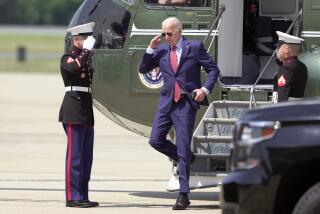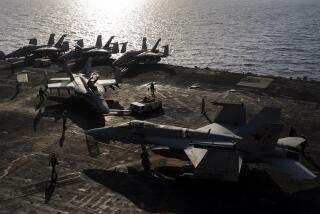Insider : Why the Pentagon Isn’t Blasting Defense Cuts
- Share via
WASHINGTON — Perhaps the most surprising thing about President Bush’s plan to dismantle nearly 3,000 U.S. nuclear warheads was the enthusiasm with which the American military embraced it.
With one notable exception, the Joint Chiefs of Staff and the Pentagon’s civilian leadership eagerly offered to give up all the weapons that Bush has dropped from the U.S. arsenal--battlefield rockets and artillery shells, nuclear land mines and all nuclear weapons carried aboard Navy surface ships. There was not a murmur of dissent over removal of the U.S. strategic bomber fleet from 24-hour alert or the stand-down of the Minuteman II missile force.
These weapons, most of them designed to fight a global war against the Soviet Union, have become not only irrelevant but more of a burden to the troops charged with their care than a threat to the dissolving Soviet Union.
U.S. commanders in Europe and Navy skippers have long complained that safeguarding these weapons consumes an inordinate amount of time, money and manpower. They take up valuable storage space on ships and military bases and require elaborate safety and security procedures that distract crews from other, more immediate training requirements.
But one weapon that Bush deleted from the arsenal--the Tomahawk nuclear-tipped, sea-launched cruise missile--was the source of some controversy within the Pentagon.
According to senior Pentagon sources, some Defense Department civilians objected to removing these weapons from submarines, arguing that they could be useful in Third World contingencies.
Cruise missiles, particularly those carried aboard submarines, are considered the ultimate “stealth” weapons. Their launch locations cannot be pinpointed, their ground-hugging trajectory makes them virtually impossible to intercept and their deadly accuracy assures that they will hit their targets.
While these officials agreed with Navy commanders that other tactical nuclear weapons aboard ships were more of a nuisance than a threat, they argued that the prospect of a bolt-from-the-blue cruise-missile attack could “concentrate” the minds of potential Third World aggressors.
But their position was rejected by Defense Secretary Dick Cheney and Gen. Colin L. Powell, chairman of the Joint Chiefs of Staff, who could envision no credible Third World threat that would require the immediate use of nuclear weapons.
No serious consideration was given to the use of nuclear weapons in the war against Iraq earlier this year. In fact, military planners made it known before the conflict started that such weapons were not even deployed to the theater for last-resort use although they were stored in Europe, only a few hours away by air.
The Navy, which has about 100 Tomahawks deployed at sea at any given time and another 250 in the inventory at bases in the United States, volunteered to remove them from ships and submarines despite longstanding objection to including those weapons in arms-control talks with the Soviets, sources said.
What changed?
The Navy has in the past resisted negotiating limits on cruise missiles because a workable verification program would involve Soviet inspectors crawling around U.S. submarines.
“There is no way to know how many missiles of a certain kind are on a ship without very intrusive procedures,” a senior Navy official said. “The Navy has never wanted to open its ships to intrusive verification procedures. But there was no resistance to the unilateral removal of those weapons from surface ships and submarines--as long as it wasn’t tied to verification, as it was not in this case.”
The current plan is to remove cruise missiles and other tactical nuclear weapons from ships and lock them in secure bunkers at U.S. naval bases, where they would be reloaded aboard ships and subs during a crisis.
Ground-based tactical weapons will be removed from Europe and South Korea over the next two years or so and destroyed.
Both moves will result in “significant savings” in operational costs, a senior Pentagon official said.
With the “hassle” of nuclear weapons removed from the field, this official added, “we can cut back on personnel reliability programs, on your command-and-control system, on the emergency action message process that you needed to launch a nuclear Tomahawk instead of a conventional Tomahawk.”
More to Read
Sign up for Essential California
The most important California stories and recommendations in your inbox every morning.
You may occasionally receive promotional content from the Los Angeles Times.










